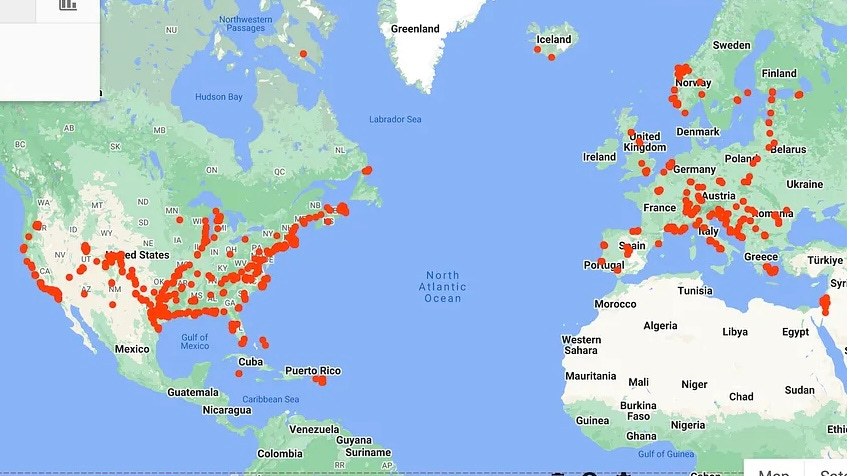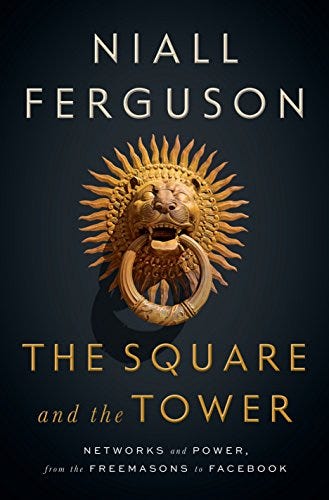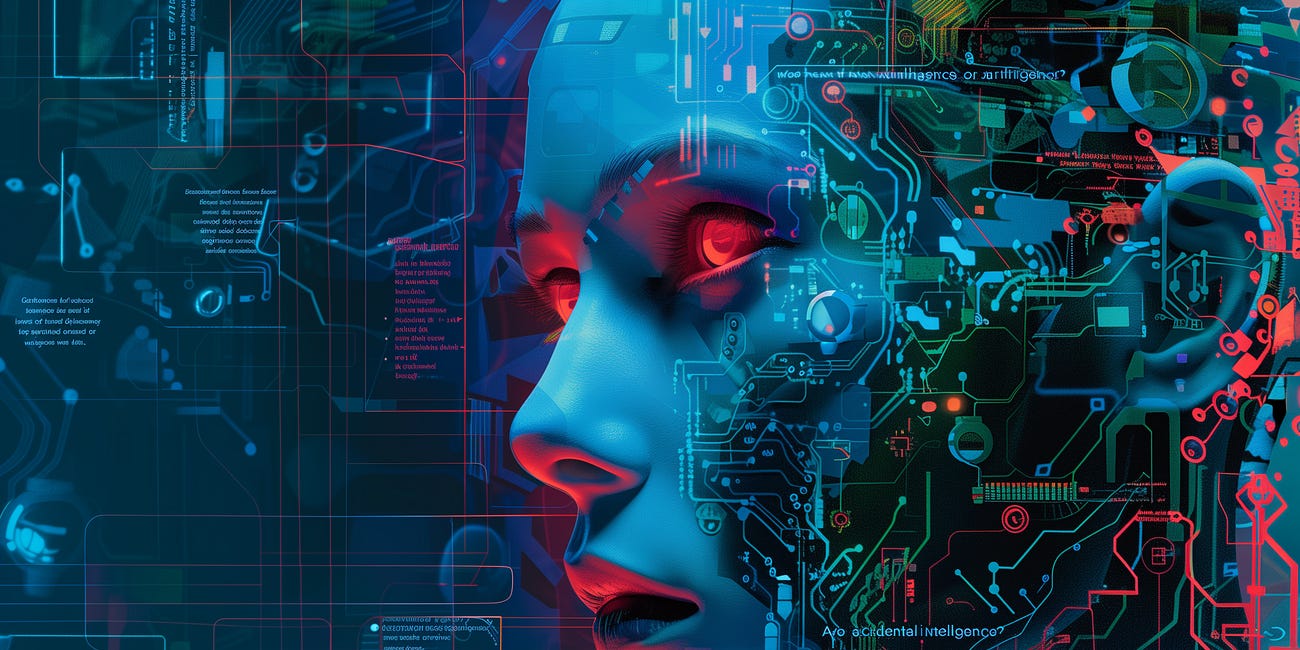Weapons of Mass Deception
In this story, we discuss the dangers of generative artificial intelligence and how to recognize the only two kinds of truth on the Internet—centralized and decentralized.
TLDR: I’ll summarize this story for you.
When you receive a Spam email offering you free money from a Nigerian prince, how long does it take you to delete it? Or what about Click Bait and Headline Traps? Those are the articles in your newsfeeds that look like amazing stories, until you tap on them and realize that you’ve been tricked.
The humans who designed those deceptions intentionally stole seconds of attention from us. Here are a few more forms of digital deception that already plague our Internet:
Deepfakes - manipulated videos or images that deceive viewers into believing false information
Phishing scams - emails to obtain sensitive information, such as passwords or credit card numbers, by disguising oneself as a trustworthy entity
Tech support scams - fraudulent phone calls from tech support that obtains access to the victim's computer
Romance scams - tricks victims into falling in love with a fake persona to get money or confidential information
Ransomware - encrypts a victim's files to make them inaccessible, then demands payment for the decryption key
Fake news - misleading news that is deliberately spread to manipulate public opinion
Auction fraud - fake transactions in online auctions where the seller does not deliver or the buyer does not pay
Malware - software designed to steal confidential data.
Investment scams - fraudulent schemes that promise high returns on investment, but do not deliver
Social engineering - psychological manipulation of individuals to perform actions that are not in their best interest
Click farms - groups of people hired to artificially boost traffic on a website, social media platform, or mobile app
The Internet is a scary place. In 2023, Cybersecurity Ventures estimated the total cost of these cybercrimes at EIGHT TRILLION DOLLARS. That was 9% of the global economy. Remember all those stories of bandits and bank robbers in America’s Wild, Wild West? Well, the Internet also has no laws, no sheriffs, and no persistent identities. The Internet is basically the Wild, Wild West 2.0.
Have you been victim of one of these cybercrimes? Share your story with us in the comments below.
Weapons of Mass Deception
The Internet is already teeming with deceptive behavior, but it’s about to get much, much worse. The proliferation of Generative Artificial Intelligence will soon make it impossible to know what is real and what is fake online. The latest generative-AI models have superhuman intelligence and many of them are open source for anyone to try. When cybercriminals incorporate these new models into their existing scams, we will be playing “4-D chess” against supercomputers whose only goal is to steal all our time and money.
Deep fakes will become normal, even for legitimate companies. By the year 2030, the Disney app will be capable of streaming individualized Disney movies just for you. The app’s generative-AI will still stream classics like “Guardians of the Galaxy”, but it will also provide each viewer with a prompt. You will be able to ask the app,
“Imagine a new Avengers movie where they fight any of the original Jack Kirby villains. Have a 30-year-old Arnold Schwarzenegger play Thor, but write his lines as a sassy Jamaican woman.” 🤣
We can watch our own trailers, give the generative-AI more notes, and then watch a new Disney movie every day. We may have to pay money to license Arnold Schwarzenegger’s digital likeness, but if we GENERATE a movie good enough to get 100k views online, Disney might actually pay us. 🤔
We might even make enough money to license Brad Pitt’s digital likeness. Brad Pitt is so good looking that he will probably star in new movies for the next three thousand years. Carrie Fisher has already starred as Princess Leia in a Star Wars movie that was written after she was dead.
Whatever generative-AI does for Disney, it will also do for porn. If you think Disney is big, porn is 30% of all Internet traffic. Porn is bigger than Disney, Netflix, Max, Paramount, and Warner Brothers Discovery combined.
Here are a few more porn stats to understand the scale. Approximately 90% of men and 60% of women have watched porn, read porn, or played sexually explicit video games. In 2018, people spent FIVE BILLION hours watching Pornhub. That’s 665 centuries of time on just one porn site, in just one year. Those people watched 109 billion videos in sessions that lasted an average of 12 minutes. Here are several more shocking porn stats:
Porn stars are statistically the most famous people on Earth, but eventually porn sites won’t even need human actors. With generative-AI, porn sites can stream individualized porn for each person. They already have all the training data they need—they know which keywords each person uses, the videos they’ve watched, where they paused, and exactly when they finished. Gross pun intended.
Finding The Truths
ChatGPT is already adding 4 billion words per day to the Internet. When cybercriminals get all their “attack-AI” online, how many more words per day do you think those models will add? So finding the truth in the exponentially multiplying noise of generative-AI will become ever more difficult over time.
So, how do we find digital information that we can trust? Since we spent the entire first chapter of this book proving that Truth is impossible in our universe, how do we find information that gets as close as possible to the truth? How do we find information that has the lowest amount of Uncertainty?
There are usually two questions I consider when determining the veracity of any information:
How improbable is this information compared to Chance?
How difficult would it be to replicate this information?
There’s no easy way to answer these questions, but there are two types of “truths” that are very difficult to replicate: Centralized and Decentralized.
Centralized Truth is information that comes from only one expert provider. Einstein gave us centralized truth. Sources of centralized truth know something that no one else knows. For example, only Google knows what everyone searches for on the Internet. That “single source” data is so valuable, that it generated $282 billion dollars of advertising revenue in 2022. Knowing something that no one else knows creates huge economic opportunities. Wall Street hedge funds have satellites in space monitoring traffic patterns in Walmart parking lots, just so their trading algorithms can make better predictions about Walmart’s revenue next quarter. Those satellites produce centralized truth.
Decentralized Truth is information from many different sources that all agree on the same story. Sources of decentralized truth know something that everyone else knows. I think of this as “Bayesian Truth” because it relies on sampling the same data point repeatedly. While any one sample could be inauthentic, the higher the frequency of the samples, the more true the datapoint is.
Yelp reviews are a good example. Yelp is an app that allows restaurant patrons to leave reviews about their dining experience on a scale of 0-5 stars. When our family travels to new cities, we don’t ask any one person for restaurant recommendations, we read what everyone is saying. If a restaurant has 5000 reviews that average 4.7 stars, then we will probably like it too. Yelp is also useful as a menu. Whenever I go to a restaurant, I scroll down through photos of the food instead of reading the menu. If 20% of the photos are Shanghai Soup Dumplings, then I get the dumplings. That's also a decentralized truth.
@travelers: Knowing where to rent a house within a city will have a tremendous effect on your experience. So when I search for houses on Airbnb, I keep a Yelp window open that shows the best restaurants, sorted by rating, as little dots on the map of that city. The tightest clusters are where we wanna be. Those areas will be a little nicer, which means those neighborhoods will be a little safer. Expensive real estate is extremely difficult to replicate, which is why wealthy people love it so much. Expensive real estate is a decentralized truth.
My other rule of thumb is always rent a house near an H&M store. It seems like whoever chooses their locations always picks the most walkable streets in every city. Once I pick a neighborhood, I then pick the bakery or coffee shop that I want to walk to each day to see how that city feels in the morning. I am so curious about this world that our family has tried most of the best bakeries, coffee shops, and ice cream shops in 45 United States and 25 European countries. That’s not hyperbole.
Like we discussed in the first chapter on philosophy, my goal for this book is to teach you how to find the truth—the fundamental frequency of life. That’s why most of the important information in this book comes from Wikipedia, ChatGPT, or the greatest research scientists on Earth. These sources have the lowest amount of uncertainty:
Wikipedia is the best source of Decentralized Truth from humans because their editing process seeks wide consensus. Wikipedia knows what everyone knows.
ChatGPT is the best source of Decentralized Truth from computers because it’s trained on Wikipedia, social media, and all our books. ChatGPT knows what everyone knows.
The world’s greatest research scientists are the best sources of Centralized Truth because their expensive science experiments enable them to know what no one else knows.
Information Networks
Now that we can recognize centralized and decentralized truths when information is fixed, let’s see what happens when it moves. Here are a few ways that information moves throughout our world:
information travels from person to person as texts, emails, and videos
information travels from computer to computer as FTP, XML, and JSON
information travels from computers to humans as push notifications, emails, web pages, and apps on our phones
information travels from humans to computers as keystrokes, taps, and voice commands
Whenever people and computers share information, they create Information Networks. My favorite book to learn about information networks is “The Square and the Tower” by Niall Ferguson.
Here’s a quote from the publisher,
From the cults of ancient Rome to the dynasties of the Renaissance, from the founding fathers to Facebook, The Square and the Tower tells the story of the rise, fall and rise of networks, and shows how network theory—concepts such as clustering, degrees of separation, weak ties, contagions and phase transitions—can transform our understanding of both the past and the present.
The book is great. It is much easier to understand than this 63-word sentence.
@bookworms: “The Square and the Tower” shows how network theory affects pretty much everything in our world, everywhere, all the time. It reminds me of the book, “Scale: The Universal Laws of Growth, Innovation, Sustainability, and the Pace of Life, in Organisms, Cities, Economies, and Companies” by Geoffrey West. You can’t unread “Scale”. Once you know the principles in that book, you will see them everywhere.
I also put “Guns, Germs, and Steel: The Fates of Human Societies” in that category. Whenever I learn anything new about the world, it usually fits neatly into the frameworks of these three books.
The Square and the Tower are Niall Ferguson’s terms for decentralized and centralized information networks, respectively:
The square is a Horizontal Network of people who make decisions together, like voting in an election or reviewing the best restaurants. Everyone is a peer in the square.
The tower is a Vertical Network of people who make decisions according to rank, often starting with a single source. The President of the United States is the head of a vertical network of information.
Each of the actors in these networks uses information to make decisions, but it’s not just the information that affects their decisions. When, where, how, why, and from whom the information is transmitted may even be more important than the information itself. Information theorist, Marshall McLuhan, coined the phrase, “the medium is the message” to describe this phenomenon.
In 1962, McLuhan wrote,
The next medium, whatever it is—it may be the extension of consciousness—will include television as its content, not as its environment, and will transform television into an art form. A computer as a research and communication instrument could enhance retrieval, obsolesce mass library organization, retrieve the individual's encyclopedic function and flip into a private line to speedily tailored data of a saleable kind.
That’s a 1960’s way of describing YouTube and ChatGPT. Advancements in communication technology since this time have slowly transformed television from a vertical network of information into a horizontal one. So we can use television to see how the medium affects the message.
Back in the 1960’s, Americans could only watch three channels on television because the cost to create a station was prohibitively expensive. This centralized the truth for the entire nation. Every American, receiving the same news, from the same source, at the same time, had a huge influence on our culture and politics. Americans during this time had the same haircuts, listened to the same music, and wore the same clothes. When Walter Cronkite signed off his broadcast each night, he said, “That’s the way it is”.
Here is Walter Cronkite discussing the risks of his famous sign off. (1 min)
Walter Cronkite delivered centralized truth. The price of the medium forced television and newspaper editors to remain objective because both sides of the political aisle read the same information at the same time. Our politicians still fought, but at least they agreed on the facts of the case. When truth is centralized, even what’s wrong is right. Unfortunately, the converse is also true. When truth is decentralized, even what’s right is wrong. When the cost of content distribution is low, the quality of the content goes down. Information shifts from facts to opinion, which is exactly what we see in our news and social media today. Information is currently cheap and getting cheaper.
It took about 50 years for television to make the journey from vertical network to horizontal network. The UHF antenna increased the total number of channels from 3 to about 10. By 1990, 60% of American households received 30 channels through coaxial cable. By 2000, digital cable increased that number to hundreds of channels. Today, there are 32 million channels on YouTube that generate commercial revenue. YouTube has a “preacher” for every truth and they compete against each other to deliver it. Compared to the 1950’s, our hairstyles have diversified, our music has diversified, and our clothes have diversified.
Even our politics have diversified. Why else would dictators like Vladimir Putin, Xi Jinping, and Kim Jong Un centralize control over their country’s media? Fortunately for America, decentralized democracies are so inefficient that they are incredibly difficult to commandeer. President T***p tried to hack our democracy with Coordinated Deception, but his lies never got more than 50% Reach. Decentralization is why America is so antifragile.
@cybernerds: Hacking a democracy of 350M people is just as difficult as hacking a blockchain with 350M nodes. That’s a very expensive 51% attack.
Also, the world laughed when Kevin Kelly predicted we would have 100,000 channels on TV one day. Now there are 32 million. If you haven’t read him, start with his book, “The Inevitable: Understanding the 12 Technological Forces That Will Shape Our Future”.
@colbertlateshow: Robbing President T***p of his digital mentions each day is funny every time I see it. “T***p” and “isPotato” are pound-for-pound the most efficient jokes ever told. Two jokes in just 13 letters is absolutely amazing. “Absolutely amazing” needs more letters than that. 😁
Effusively Diffusive Technology
When new a technology is invented, control of its power is typically centralized with its inventors and financiers. Then, as in the case of television, advancements to that technology slowly decentralize that power over time.
It’s easy to see in computer science because it happens so frequently. For example, in the 1950’s computing was so expensive that it was centralized on a Mainframe, which required users to login from remote terminals. As the cost of microprocessors came down, computing decentralized into the personal computers (PC) in our homes.
As the costs of creating computers went down, the price of searching them went up. So Google centralized computing power again and users went back to remote logins—this time called a web browser. As our battery and wireless technology improved, mobile phones decentralized computing power again. Not only is there a personal computer in each person’s house, now there is a personal computer in each person’s pocket.
The next big centralization in computer science isn’t the metaverse, it’s ChatGPT. Users are already flocking to the new remote login—this time called a chatbot prompt. The prohibitive costs to make ChatGPT and other frontier AI models is similar to the prohibitive costs of building a television station in 1930. Only a handful of companies can afford to do it. So this means ChatGPT is like Walter Cronkite 2.0. There are 100M people asking ChatGPT questions about the universe and it is answering every one of them from the same dataset. So whatever ChatGPT says:
@historynerds: For more history of computers and the Internet, read “The Idea Factory: Bell Labs and the Great Age of American Innovation” by Jon Gertner. Bell Labs invented the transistor, automated switching, photovoltaic cells, fiber optic cable, Information Theory, and Game Theory. Shockley, Shannon, and von Neumann all worked there together. 🤩
American Telephone and Telegraph was the Internet for almost a century.
We close this story on digital trust with money because money is literally information. When you hand $1,000 cash to the teller at your bank, what you receive in exchange is an increase to your digital account balance. Most of the money in the world is completely electronic—it’s kept in bank account databases and corporate capitalization tables, which are usually just spreadsheets. 😬
Today, the most cutting-edge finance is called Decentralized Finance (DeFi), but technology has been decentralizing money for centuries. A thousand years ago, almost all commercial finance was under the centralized control of kings. A government’s power to tax (aka the local monopoly on violence without repercussion) was the only credit strong enough to build bridges and fund wars.
Sovereign control over money and credit first started to crack in 1300 when a Florentino merchant, named Amatino Manucci, invented Double Entry Accounting. Today, we know it as “the receipt”. Receipts increased trust between merchant banks, which allowed them to transfer funds without actually transferring the physical gold.
Florence became the hub of a burgeoning merchant bank network that spread credit and liquidity all over Europe. The banks in Florence even managed the revenues for the Pope—the largest revenue stream in the world. Whenever I walk around Florence and admire all the Michaelango and Donatello statues that decorate their city I think, “Wow, receipts were such a big deal”. 🧾
The center of world finance migrated from Florence to London around 1600 with the formation of the East India Company. The “decentralizing invention” this time was called the Joint Stock Company. This invention allowed non-sovereign people to pool their capital to fund projects and expeditions that were previously only affordable by kings. For example, back in 1492 when Christopher Columbus went looking for financing, the King of Spain was the only guy on Earth rich enough to sail 3 fully loaded warships off the end of the Earth just to see what happens. 🐲
The Joint Stock Company allowed the British elite to invest heavily in global trade networks. British colonies sprouted up all over the Earth and produced economic returns on their Venture Capital for centuries. Venture capitalists today still call their profit “the carry” because it used to be measured in tonnage. The British didn’t liberate their weakest colonies until 1960, which is why 18 different countries around the world all share that year of independence. That's almost 10% of all countries.
Global finance decentralized even further with the Limited Liabilities Act of 1855. In a joint stock company, the shareholders are liable for any debts accrued by the company, so only the wealthiest individuals can afford to carry the pro rata share of liability. The Limited Liability Corporation formally limits shareholder liability to just the assets held by or pledged to the company. This enables a much wider range of individuals to participate in private equity, which creates more liquidity in the economy. Fortunately, the LLC was invented just in time to fund the Second Industrial Revolution.
Today, Bitcoin and other DeFi technologies are looking to disintermediate the central banking system altogether. In a central banking system, trust is provided by the state because people trust whatever denomination they can pay their taxes in. That’s as liquid as money gets. But with DeFi currencies, there is no central bank to trust because their blockchain technologies distribute trust across the entire network. So:
An account balance at a bank is a centralized truth on a vertical network of information headed by the state.
An account balance on a blockchain is a decentralized truth on a horizontal network of information.
Unfortunately, blockchains are not a panacea solution for global finance because the decentralization is extremely expensive to operate. Each transaction on the Bitcoin Network consumes over $100 of electricity. The Bitcoin Network needs more power every year than all the people of Sweden, including all their saunas.
@americans: For now, we will just have to settle with the US Dollar, which is anonymous to transact, fungible, and has no history of who possessed each one.
Just imagine if we could pay our taxes in Bitcoin. We could figure out which of our tax dollars purchased bombs to destroy some poor foreign neighborhood, and which of our tax dollars purchased a new heart for some old person 1000 miles away who ate cheeseburgers and milkshakes their entire life. 🫀
Continue reading…
Table of Contents
We need your help
@christians: We are a 501(c)3 nonprofit ministry dedicated to spreading the Good News of Jesus Christ to academics, scholars, and scientists because of their tremendous influence on all our world views. Their opinions directly affect our children’s education, the media, national policy, and budgets for future scientific research. Please consider investing some of your tithe this year into our mission of eradicating the false doctrine of Darwinian Evolution.
How can we improve this story? Please let us know in the comments.
Outtake from Weapons of Mass Deception
Everything in real life will be fakeable too. For example, De Beers and other natural diamond miners campaigned against “cultured diamonds” for decades. Then De Beers reversed course, investing $100M to launch their own cultured diamond brand because natural diamonds are following the same economic path as natural pearls. The battle between cultured pearls and natural pearls started much earlier in history and today 100% of pearls used in jewelry are cultured. That’s because cultured pearls are cheaper, better quality, and have a lower environmental impact.
Here is Maksud Agadjani to give you the truth about lab diamonds—they are better than natural diamonds. (6 mins)
Even steaks in the future will be “cultured” because of lower costs and environmental impact. Why buy the cow when you can get the tenderloin for free? Here is a short video to learn more about the future of meat. (3 mins)



















